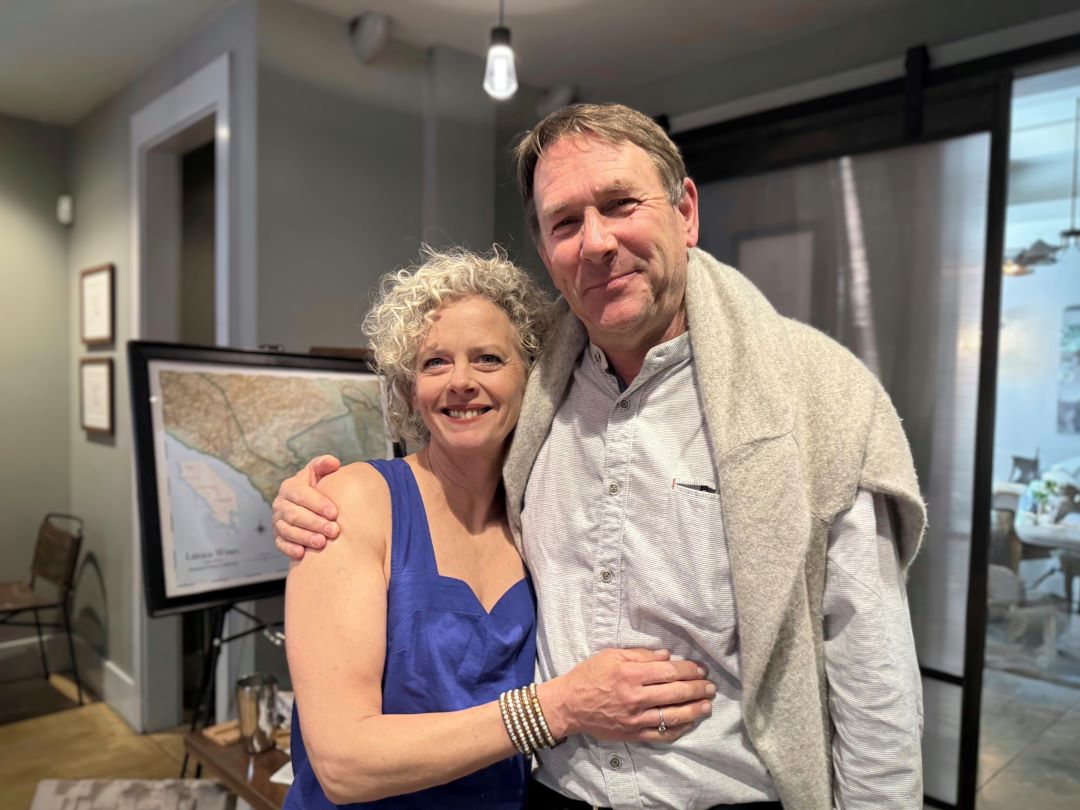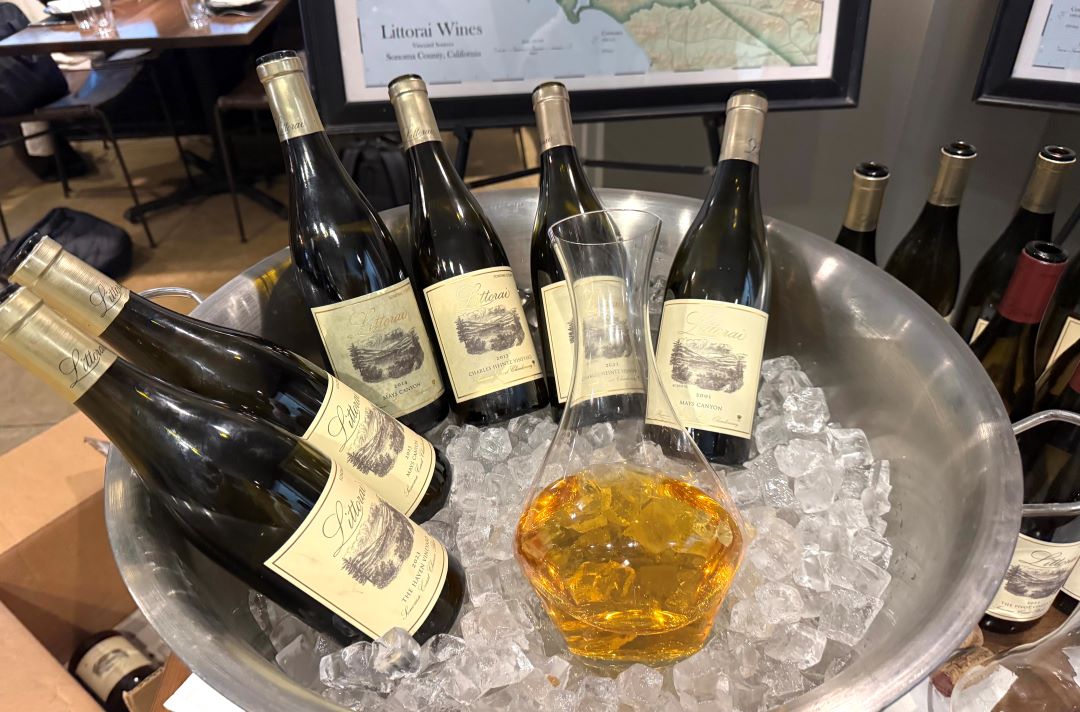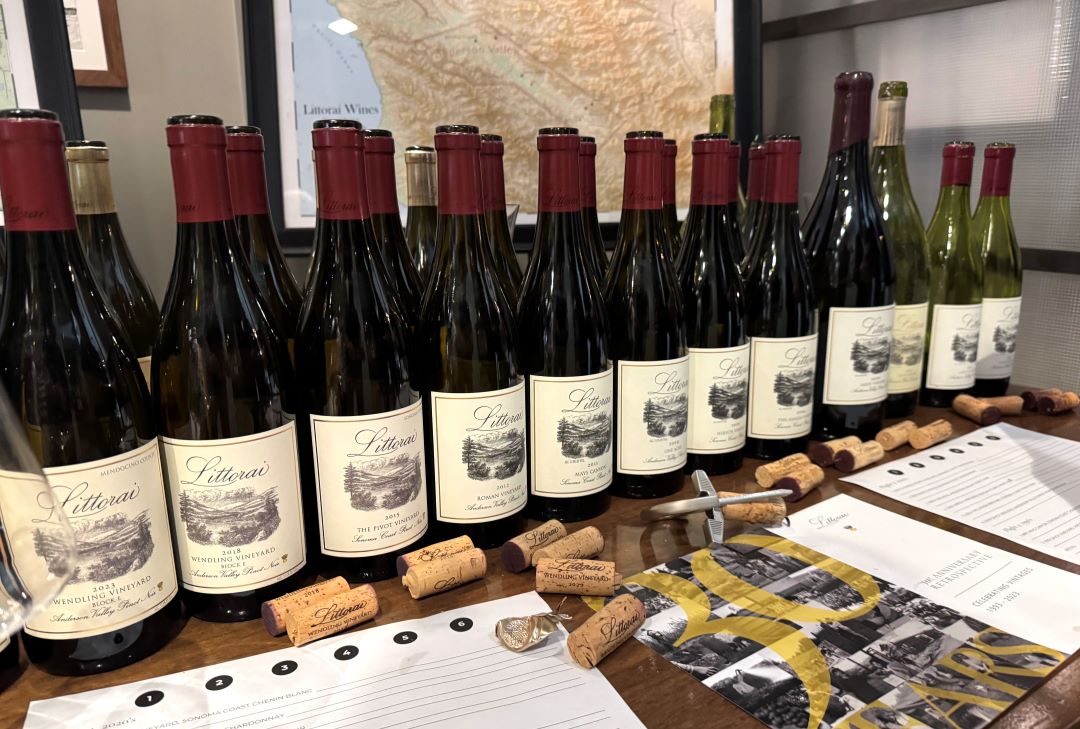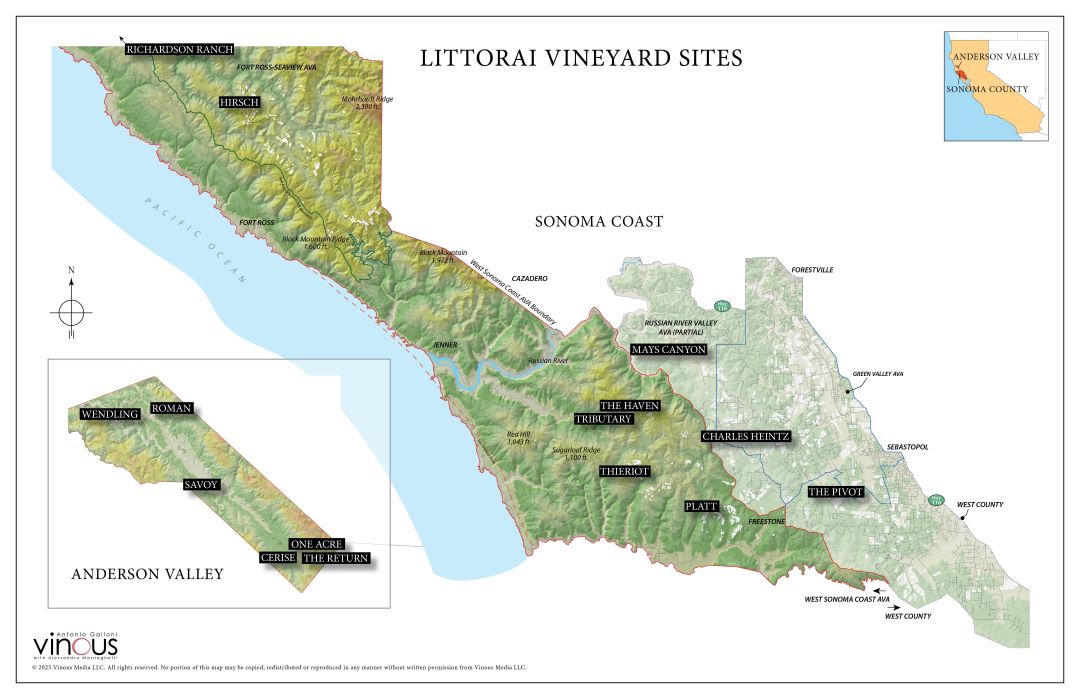Browse using the new Vinous website now. Launch →
Printed by, and for the sole use of . All rights reserved © 2015 Vinous Media
Littorai: The First Thirty Years
BY ANTONIO GALLONI | JULY 18, 2025
From humble beginnings in the early 1990s, Ted and Heidi Lemon quietly built one of the most impressive wineries in the United States. Along the way they influenced countless younger winemakers and spearheaded the development of what are now vibrant winegrowing communities in Anderson Valley and the West Sonoma Coast.
This report combines tasting notes and impressions from two recent tastings. The first set of wines was part of the 30th anniversary tastings Littorai recently hosted, showcasing their wines all the way back to the early days. Revisiting 18 wines directly from the estate’s cellar was quite a revelation. Those notes are augmented by an equally eye-opening vertical of 2016s that was one of the featured tastings at our Vinous Icons event in February 2025. To that I add my perspectives from visiting Littorai and tasting with Ted Lemon every January over the last 15 years or so.
Littorai has long been admired for a philosophy that is all about elegance, vibrancy and understatement. In some circles the not-so-subtle implication is that wines made with this approach are inherently more pedigreed than opulent, richer wines. I do not share that view. As a young student at Berklee, I was trained to appreciate all styles of music, and then to understand the nuances and details within each style. That’s an approach I have carried over to how I think about wine. The Littorai wines aren’t reference points because they are made from sustainably farmed vineyards or with a light hand in the cellar. They are reference points because they embody the single most important attribute vineyard-designate wines must convey: deep, profound expressions of place.

Heidi and Ted Lemon at Compline in Napa after a
presentation of their wines dating back to 1995.
In the Right Place at the Right Time
Ted Lemon has without question lived one of the most extraordinary careers in wine. Originally from Bedford, New York, Lemon’s first exposure to France came at the age of 15, when he spent a year abroad living and studying in Burgundy during high school. Lemon majored in French literature at Brown University. A semester abroad at the University of Dijon proved to be pivotal. It was here that Lemon took a wine appreciation class and became interested in wine. Lemon returned to France in 1980 and studied viticulture and winemaking in Dijon.
As part of his studies Lemon interned at several wineries, including Dujac, Roumier, de Villaine and Bruno Clair. Lemon lived and breathed the old Burgundy, one might even say the real Burgundy. These were far humbler times than what visitors see today. The wines were known only to insiders and even the best domaines struggled to sell their production. Lemon gained the trust and respect of some of the leading vignerons of the day, a remarkable achievement for a young American winemaker in his early twenties working in the patriarchal Burgundy of the early 1980s.
“The owners were very welcoming, but the workers, well, that was a different thing,” Lemon explained, recounting his first experiences with a new culture. “It was very much old school. What mattered was who finished pruning a row fastest. If you were slow, no one respected you. It almost came to blows at times. Thanks to producers like Jacques Seysses I got to experience three-star restaurants, which I certainly did not have the money for. I began to understand the food and wine culture, specifically the role of wine at the dinner table.”

A stellar lineup of Littorai whites.
“I then moved back to California and tried to write the great American novel for a year but failed miserably,” Lemon continued. That year Lemon worked harvest with Josh Jensen at Calera. Jensen had interned at Domaine de la Romanée-Conti and Dujac in 1970 and 1971. He planted his estate on Mt. Harlan with cuttings from those two estates. An urgent call arrived from Burgundy in November. Guy Roulot had passed away suddenly. The family pleaded Lemon to return to Burgundy to run the domaine, as Guy’s son, Jean-Marc, was pursuing an acting career in Paris. Lemon drove back east and rushed to get his work papers in order. He became the first American winemaker to lead a domaine in Burgundy.
“I got to experience three very unique vintages: 1982 and 1983 could not have been more different, and then 1984 was not ripe at all,” Lemon told me of his time Burgundy. “The 1982s were low in acid. It was a huge vintage in terms of production. Family cellars that had not been used for years were full of wine. Growers like Bernard Michelot suggested bottling early and that it would be an early-drinking vintage. What did I know? I was just a kid. But a bunch of the wines aged very well. The wines were so seductive, so appealing, so well balanced.”
Between botrytis and higher sugars, the next vintage was far more challenging. “The 1983 vintage was very controversial,” Lemon explained of what was surely one of the most memorable episodes of his young career up until that point. “Domaine de la Romanée-Conti was severely criticized over their wines. Lalou [Bize-Leroy] and Aubert [de Villaine] asked me to come over and taste with them. Just the three of us. Blind. There was no question the wines reflected the vintage. There was rot. But there were more existential questions. ‘Are the wines faithful to site? Should we release them?’ they asked me. I mean, I am 23 years old at the time. But I had been to the winery at least ten times over the prior year and a half. This was back in the days when André Noblet was the cellar master. The corkscrews were a bit looser than they are now,” Lemon quipped.
The 1984 vintage proved to be a turning point for Ted Lemon in Burgundy. “It was a miserable vintage,” Lemon recalled. “I remember picking Les Tessons on a day full of rain. There were no signs of the weather changing. Morale among pickers was low.” Lemon came face to face with the reality that as a young American who wasn’t a member of the family, he had no chance of getting the vineyard crew to follow his directions. Only a family member could do that. “The Roulot wines were already among the very best in Meursault. All the protocols were in place, but they needed to make a few small improvements to get to the next level. I tried to convince the family to do certain things but the only way that was going to happen was with Jean-Marc at the helm. I thought he could balance both careers. As hard as 1984 was, it was not my most challenging harvest. That was 2008 in California because of smoke taint.”
Lemon returned to California after his time in Burgundy and became a consultant to several wineries in Napa Valley and Oregon. In the late 1980s Lemon joined a tasting group in Calistoga that focused on Chardonnay and Pinot Noir. Fellow members included Tony Soter, Helen Turley, John Wetlaufer, David Ramey, Burt Williams, Steve Kistler, Cathy Corison and Chris Howell, a veritable who’s who of winemakers who would all go on to play pivotal roles in the California wine industry. One can only imagine what those sessions must have been like. “We never ranked wines,” Lemon explained. “The point was the discussion. There was so little wine from the Sonoma Coast, but the few things we tasted I thought were really interesting. Burt [Williams] made a 1988 Pinot Noir from Summa that I remember as a clear standout in a lineup of Grand Cru Burgundies.”
Ted and Heidi Lemon met in 1989 in Napa Valley. She was living in Germany, but was back home in California to attend her brother’s high school graduation. The pair hit it off and Ted convinced Heidi to stay. Heidi later worked at several top estates, including Domaine Chandon and Long Vineyards on Pritchard Hill. She was also Warren Winiarski’s assistant at Stag’s Leap Wine Cellars for a time.

A trip through key vintages and sites in Pinot Noir.
Anderson Valley and West Sonoma Coast: The Early Days
By 1991, the Lemons were ready to find an ideal site. They spent much of that year traveling through the western coast of the United States. “We were very serious about Oregon at one point, but the geological complexity of the Sonoma Coast and Anderson Valley was intriguing for making wines of place,” Lemon elaborated. “For us, geology and climate do not stop at county lines—we think of these things as a continuum. There are more similarities in terms of geology and weather between the West Sonoma Coast and Anderson Valley than you might expect.”
The Lemons named their new winery Littorai, combining the Latin for coast (littor) with the Greek plural (ai). From the beginning, the Littorai philosophy centered on three pillars: the right sites, the right plant material and the right ownership. “Many times we would have an initial conversation with an owner, but then there would be no second discussion,” Lemon explained.
The West Sonoma Coast, or the “true” Sonoma Coast, was and still is a very young region. The first vineyards were planted in the early 1970s, starting with Bohan Dillon in 1972, followed by Hill Crest in 1974 and Hirsch in 1980. “The big movement started in the 1990s. Before that the region was virtually unknown in terms of the production of wine grapes,” Lemon explained. “Anderson Valley was quite different. Plantings were scattershot with all sorts of things, from Riesling to Cabernet Franc to Pinot Noir. It was only with the arrival of Roederer Estate and their focus on Chardonnay and Pinot Noir that things began to change.”
“The tendency toward riper wines in the 1990s wasn’t just related to the preferences of critics of the day, but, at least on the Sonoma Coast, the vineyards were young,” explained Lemon as he recalled the early days. “Winemakers were young too, and vineyard people had no experience. David Hirsch may have had a few acres of vineyards in the 1980s, but only got into the wine business in 1990. Steve Kistler and I got caught flat-footed in 1994 because we did not irrigate enough. In the context of what was going on then, it’s understandable. Then, over time, we all matured.”
![]()
Ted Lemon discusses the lay of the land and the 2022 Pinot Noir The Haven Vineyard at the West Sonoma County masterclass during Vinous Icons 2025.
The 2000s: Winds of Change
By the 2000s, Ted and Heidi Lemon were ready for the next major step. An important and decisive move to organic and biodynamically farmed vineyards started with The Haven and Mays Canyon in 2000. Savoy became organic in 2002 and is the oldest organically farmed vineyard in Anderson Valley. The rest of the sites all became organic or biodynamic in the years that followed. “We immediately noticed that the soils became alive and much more vibrant than before,” Ted Lemon explained. “We needed less water as well. One of our two blocks at Hirsch is no longer irrigated, while most of Heintz is also no longer irrigated.” Today, Littorai’s holdings are split between estate vineyards and long-term leases.

The Vinous Map of Littorai Vineyard Sites, by Antonio
Galloni and Alessandro Masnaghetti. © Vinous, 2025.
On Winemaking
Ted Lemon is one of the most thoughtful and articulate winemakers I have met in the more the more than 20 years I have been reviewing wine. Among other things, he is intensely self-critical. Winemakers generally fall into two camps. The first make their wines the same way, every year, regardless of vintage. Others adopt a more flexible approach that might mean making the wines a bit differently, depending on the specific characteristics of each growing season. Lemon falls into the latter group. Stem inclusion in the Pinot Noirs varies from year to year and wine to wine. There is no recipe. Similarly, most of the Pinots are bottled in the spring of the second year after harvest, but in lighter vintages like 2023, some wines were bottled earlier.
Chardonnays have also seen some evolution. For example, between 1999 and 2003 wines were on their lees for 16 months. “I was really influenced by Réne Lafon’s whites,” Lemon told me. “Over time, though, I found extended time on lees led to variability in our wines. When it works the wines are magnificent, but when it doesn’t the wines come across as too biscuity. In 2004 and 2005 we went to a single racking into tank for a few months to help retain freshness. We find our Chardonnays are more consistent with this approach.”
![]()
This collection of 2016 Pinot Noirs was full of highlights.
The 30th Anniversary Tasting at Compline
This remarkable retrospective started with a sampling of 2023s, the current vintage, and then worked back to 1995, passing through many highlights of Ted and Heidi Lemon’s brilliant career. The foresight to hold wines back for retrospective tastings like this one and the others Littorai has hosted recently, is yet another sign of seriousness of purpose—an exceptionally rare quality in the world of wine.
2016 Retrospective at Vinous Icons
The 2016 retrospective at Gramercy Tavern in New York was equally illuminating. I loved the 2016s on release but had not tasted them comprehensively in many years. “It was a high whole-cluster vintage,” Lemon explained to our guests. Even though I rated the wines highly on release, I don’t think I expected them to show so brilliantly across the board. Many of the wines have really blossomed over the last several years.
Experiencing the two tastings within a few months of each other was extremely illuminating. I gained more insight into the personality of each site, and how the wines mature over time. I attended Littorai’s 20th Anniversary tasting in New York, then the 30th in Napa. I am curious to see what the 40th will bring in time.
© 2025 Vinous. No portion of this article may be copied, shared or re-distributed without prior consent from Vinous. Doing so is not only a violation of our copyright, but also threatens the survival of independent wine criticism.
You Might Also Enjoy
Ted Lemon at the West Sonoma Coast Seminar, Vinous Icons, February 2025
Sonoma and Neighbors 2022 & 2023: Opposites Attract, Antonio Galloni, January 2025
2022 Sonoma: A First Look, Antonio Galloni, January 2024
Sonoma’s Sensational 2021s, Antonio Galloni, August 2023
California North Coast: Eyes Wide Open, Antonio Galloni, January 2022
